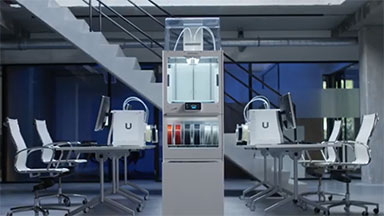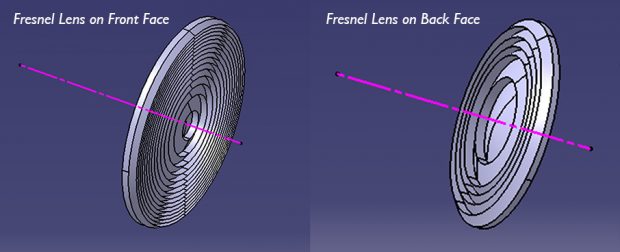
Beginning with the 2018 release of SPEOS, users can now automatically design Fresnel lenses on back-face to improve the efficiency of a projection lens. Image courtesy of OPTIS.
Latest News
March 14, 2018
OPTIS, a developer of simulation software for light, human vision and physically correct visualization, has announced the 2018 release of SPEOS, its core light simulation software. In related news, the company announced SPEOS Lighting for SOLIDWORKS.
OPTIS describes SPEOS as capable of providing light simulation based on the physical laws of optics. With it, engineers can better understand and control the behavior of light in and on their product designs, and it can help improve the speed of designing and rendering optical and optoelectronic devices such as vehicle lights, displays and lens systems. SPEOS comes with a material editor. Its comprehensive set of libraries of optically measured materials are said to be ready to apply to any CAD model. All parts are then physically defined for accurate and realistic simulation of the light’s propagation. Modules are available for such applications as visual ergonomics, windshield analysis and optical shape design.
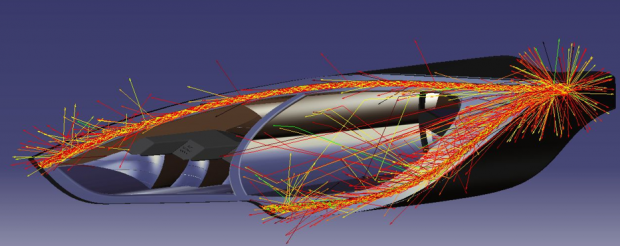 OPTIS has released the 2018 edition of its SPEOS light simulation software. Image courtesy of OPTIS.
OPTIS has released the 2018 edition of its SPEOS light simulation software. Image courtesy of OPTIS.SPEOS integrates with four major CAD solutions: CATIA, NX, PTC Creo and SOLIDWORKS. (The latter version was previously known as OptisWorks.) The SPEOS interface reportedly makes it easy for non-specialists to use while offering advanced functionality for optics experts.
Version 2018 contains new features for the automotive industry, including headlight simulation and the simulation of internal materials, according to the company. In particular, the company says that SPEOS 2018 incorporates a mode intended to push the limits of the visible distance and width of headlight beams while maintaining regulatory compliance. SPEOS 2018 now also includes the ability to simulate solid-state LiDAR (light detection and ranging) technology.
 Beginning with the 2018 release of SPEOS, users can now automatically design Fresnel lenses on back-face to improve the efficiency of a projection lens. Image courtesy of OPTIS.
Beginning with the 2018 release of SPEOS, users can now automatically design Fresnel lenses on back-face to improve the efficiency of a projection lens. Image courtesy of OPTIS.New functionality in SPEOS 2018 offers the ability to make optical free-form surfaces as well as the ability to perform dedicated head-up display (HUD) optical system analyses. It also holds a digital light processing (DLP) library dedicated to HUD in automotive.
SPEOS 2018 now supports MOEMS (micro-optoelectronic mechanical systems) technology for sensing or manipulating optical signals on extremely small scales. Its texture mapping capabilities have been enhanced so that designers can now reproduce the exact effect of textured materials virtually, allowing them to test and choose the optimal materials for their project.
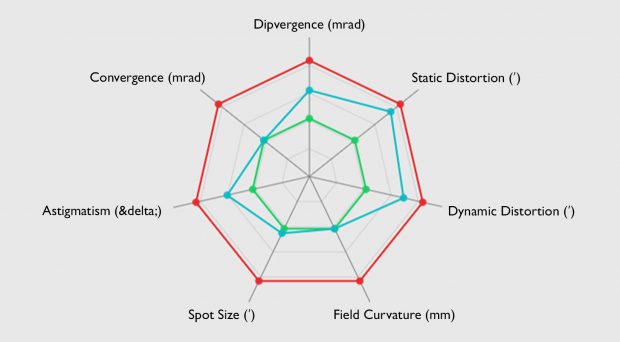 The OPTIS Library now includes a dedicated test for the SAE J1757-2 optical metrology standard for automotive HUD (head-up display) systems. Image courtesy of OPTIS.
The OPTIS Library now includes a dedicated test for the SAE J1757-2 optical metrology standard for automotive HUD (head-up display) systems. Image courtesy of OPTIS.Other improvements in SPEOS 2018 include the ability to generate ray files in the IES TM-25 format for describing the emission property of light sources and the ability to measure and certify illumination on the fly. Its light propagation algorithms have been enhanced to increase overall efficiency.
The OPTIS Library now includes a dedicated test for SAE J1757-2 optical metrology standard for automotive HUD. SPEOS HUD Optical Analysis, the company says, enables OEMs to implement their own HUD requirements and generate reports in accordance with the SAE standard automatically.
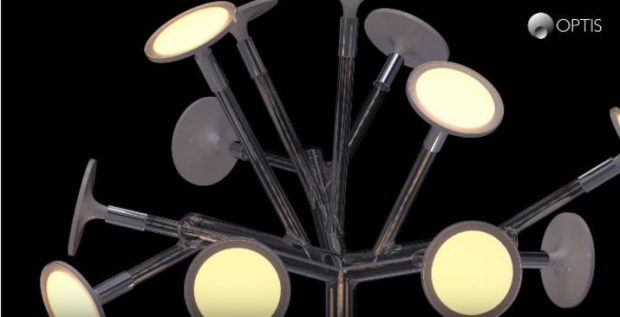 SPEOS Lighting for SOLIDWORKS allows for virtual prototyping and simulation of a diverse range of lighting systems, such as luminaires, solar panels and intelligent sensors. Image courtesy of OPTIS.
SPEOS Lighting for SOLIDWORKS allows for virtual prototyping and simulation of a diverse range of lighting systems, such as luminaires, solar panels and intelligent sensors. Image courtesy of OPTIS.SPEOS Lighting for SOLIDWORKS provides users access to the core of OPTIS technologies and directly integrates with the SOLIDWORKS interface. It can be applied to a range of applications, including the design of light beams for a luminaire, solar panel design and simulating intelligent sensors. The company stresses that SPEOS Lighting for SOLIDWORKS is not just for lighting manufacturers but trades as diverse as design, architecture and interior design.
SPEOS 2018 is ready for HPC (high-performance computing). SPEOS for HPC is available in an on-site configuration and as an SaaS (software as a service). For more info on SPEOS, visit OPTIS.
Go here for details on what’s new in SPEOS 2018.
Watch a video introduction to SPEOS.
Watch the OPTIS & SOLIDWORKS video.
See why DE‘s Editors selected SPEOS 2018 as their Pick of the Week.
Sources: Press materials received from the company and additional information gleaned from the company’s website.
Subscribe to our FREE magazine, FREE email newsletters or both!
Latest News
About the Author
Anthony J. Lockwood is Digital Engineering’s founding editor. He is now retired. Contact him via [email protected].
Follow DE




